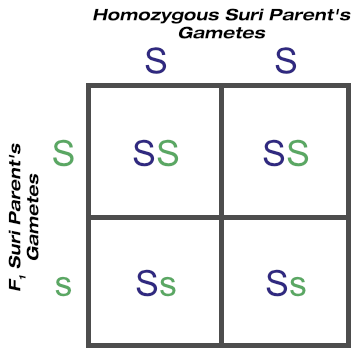Working With Simply-Inherited and Polygenic Traits in a Breeding Programme
As mentioned, simply-inherited and polygenic traits are equally subject to the same Mendelian and non-Mendelian inheritance forces. And both can have gene and genotypic frequencies shifted by selection and mating systems. But while it is often straightforward to observe the effect of a simply-inherited trait owing to the small number of genes involved, this isn’t the case with polygenic traits. It is often not even known how many genes are involved in a particular polygenic trait, nor what the effect of each may be.
It is because of this complexity that breeders must take very different approaches when working with simply-inherited and polygenic traits.
Working With Simply-Inherited Traits
Simply-inherited traits are often influenced by just one locus, and at most a small number. Their either/or nature results in qualitative (categorical) outcomes that are readily observed and recorded. This characteristic enables genotypes to be predicted in many cases, which a breeder may then use to their advantage.
Take the suri and huacaya alpaca types. The suri has an Angora goat-like dreadlocked appearance while the huacaya has a sheep-like woolly appearance. Suri or huacaya fleece style is a simply-inherited trait with one locus, ‘S’.
The suri allele (’S') is dominant to the huacaya allele (’s’), thus a suri can be ‘SS’ or ‘Ss’. Huacayas can only ever be ’ss’.
Suri breeders sometimes cross huacayas with purebred (homozygous) suris, for example to introduce a particular colour into their herd. The resulting F1 generation is:

© Optimate Group Pty Ltd
The F1 offspring, all heterozygous suris, would then be backcrossed to homozygous suris. ‘Backcrossing’ is to cross the F1 offspring back to the homozygous, desired, genotype (’SS’ in this case) to increase the likelihood of producing more animals with the desired phenotype (suri in this case). This is not an F2 generation (the result of crossing two F1 groups), but a BC1 one (’BC’ stands for ‘backcross’):

© Optimate Group Pty Ltd
But which of the offspring are homozygous and which are heterozygous? You can’t tell just by looking at them as you can with huacayas. Potential purchasers want the reassurance of buying a homozygous suri, and a breeder can command more for this reassurance. The breeder could perform a test mating (or test cross), by crossing these offspring with huacayas. In the absence of a genetic test for the locus in question, this is a common technique when breeding and selecting for simply-inherited traits.
(The caveat here is that time is needed first for an animal to reach sexual maturity, and then for the many matings that must be done to determine the genotype definitively. And it is much easier and quicker to do multiple test matings of a male than of a female.)
Here, heterozygous suris, statistically, would be expected to produce one huacaya from four matings to huacayas, but a homozygous suri never will:

© Optimate Group Pty Ltd
The one-in-four chance of producing a huacaya is of course only the calculated outcome. Four suri offspring from four matings to huacayas doesn’t guarantee the test animal is homozygous. These results could be due to chance, and the fifth, or even tenth, mating might be the one that produces a huacaya.
It follows that the higher the number of matings when crossed to huacayas that produce only suris, the more likely (but not guaranteed) that the suri parent is ‘SS’ homozygous. But at what number of matings is it ’safe to stop’? We’ll be delving into the maths of test matings in more detail in the next section.
Working With Polygenic Traits
It’s a simple in theory, though lengthy and tedious, procedure to determine whether a suri is ‘SS’ or ‘Ss’, and similarly for any simply-inherited trait in any other species. But where do you begin with something like milk production or meat yield, which is influenced by many genes, some of which may not have even been determined yet, or their effects fully understood?
Breeders require a different approach when working with polygenic traits. And that approach is to determine, statistically, what the net effect of an individual’s many genes are on a particular trait. For these we need mathematical tools to assess, quantitatively, an animal’s performance and breeding value, and there will be much coverage of these to come!
This concludes the section on simply-inherited and polygenic traits. The next section will be about the different strategies required when selecting for a simply-inherited or polygenic trait. We’ll begin with a series of posts on selection strategies for simply-inherited traits — test matings essentially. After that we’ll cover the more involved selection strategies for polygenic traits, by exploring concepts such as breeding value and heritability and how to calculate these.
Leave a comment